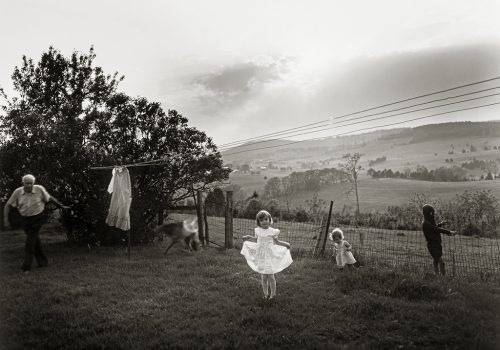Sally Mann stands among the major artists of our time. Her work is powerful, mysterious, and beguiling. The retrospective of her photographs currently showing at The Getty Center is a testament to her lifelong commitment, both to digging deep into herself, and the things and people around her.
A Thousand Crossingsrecognizes the progression of her art with multiple rooms devoted to her work and a hundred and ten pictures that illuminate five different stages on her journey.
Familyis where it begins, pictures she made of her children starting in the eighties that showed us their lives as she saw them and as she imagined them, showed us how compellingly strange it is to bear children. The images reveal her strengths from the beginning, the slow approach of her large format camera, her considerable skills as a printmaker, and her willingness to look deep and risk others displeasure with what she saw.
Then comes The Land, pictures of southern landscapes made in Virginia, Georgia, Louisiana, and Mississippi. These images, made in the nineties using antique lenses and wet plate processes, are dark and deeply beautiful pictures of the land she loves. Here also are pictures of the land that reflect on its tortured past, the place where Emmett Till’s body was found, the river where they threw him in to die.
Last Measure, for many southerners the War Between the States is an ever-present, unfinished business. It colors their relationship with the rest of us and with the land where their Americans lost the war they never forget. Here are pictures dark and brooding, the corpses buried but their spirits filling the images of what remains. Before the politics of the present, the politics of the civil war shaped what was to come, and that war which kept us together has left wounds that are still not healed. To see these pictures of battlefields long grown quiet is to see some of these wounds made manifest.
Abide With Meis about race and history, pictures from four series made between 2008 and 2012. Here are pictures of land and churches but also portraits of Virginia Gee-Gee Carter, a woman who worked for Mann’s family and helped her understand something of the complex relationship between the races in the south. And now you come to her haunting portraits of African American men, the prints made so large you cannot miss the stories written on their bodies and faces.
What Remainscomes back full circle to Mann’s family but now transformed by time. Aging and suffering are here writ plain but also the quiet spirit that endures. Everything she has learned along the way is now brought to bear on everything that has happened. If you have come this far, you have witnessed an artist’s journey as much as the stories she has told with her camera.
Sally Mann’s work as a photographer is matched by her work as a printmaker. In the early photos she shows you what a powerful printer she is, she announces it with every image. In the later work, she just IS an amazing printer and hides it in the glory of her art. The prints, like W Eugene Smiths, are dark with everything subordinated to the thing that holds her interest and makes it yours, and there is something magical in that. She regularly makes images that seemingly have none of the methodology artists use to make you look, and yet you do. They somehow create a feeling in the viewer, a sense that there is something lurking, a something that communicates without becoming visible. Over the years she has offered us this singular vision turned towards a variety of subject matter, always with her impressionist sensibility, often mixed with her dark visioned realism, ever her own.
A few facts, the show was organized by The National Gallery of Art, Washington and the Peabody Essex Museum, Salem Massachusetts. Thank you for that. It has traveled to The Getty which has mounted it with all the respect and attention it deserves. The show fills a generous number of rooms, every picture given the space it deserves, and the beautiful darkly painted walls on which the prints are mounted provide a visual resting space from which the images emerge. I think we sometimes neglect to talk about the importance of the surroundings in which things are seen. Looking at these images on a bright white wall in a crowded room would be a very different experience from approaching the pictures as they are hung and lit at the Getty. Here, nothing distracts from the image, and I deeply appreciate that.
Sally Mann, A Thousand Crossings continues in Los Angeles until February 10th then travels to the Museum of Fine Arts in Houston, the Jeu de Paume in Paris and finally the High Museum of Art in Atlanta. It is a beautiful and affecting show, and not to be missed if you can possibly see it. If that isn’t in the cards, the exhibition catalog, Sally Mann, A Thousand Crossings provides 320 pages of essays and imagery, the next best thing to being there.
Andy Romanoff
Sally Mann – A Thousand crossings
Getty Center, Los Angeles, for information; http://www.getty.edu/
Exhibition Tour
- National Gallery of Art, Washington, March 4–May 28, 2018
- Peabody Essex Museum, Salem, June 30–September 23, 2018
- The J. Paul Getty Museum, Los Angeles, November 16, 2018–February 10, 2019
- Museum of Fine Arts, Houston, March 3–May 27, 2019
- Jeu de Paume, Paris, June 17 –September 22, 2019
- High Museum of Art, Atlanta, October 19, 2019 –January 12, 2020
















